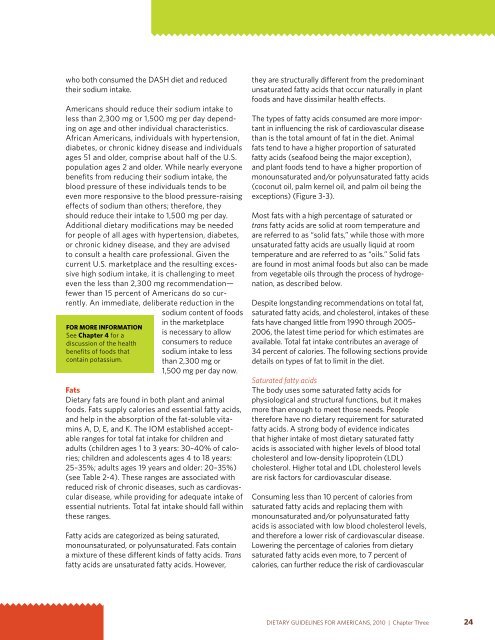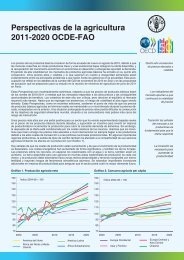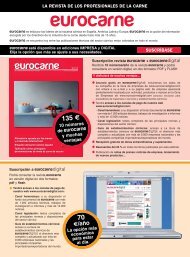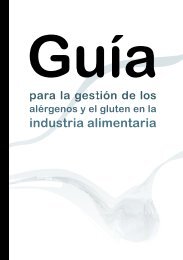contribute 7% of the sodium in the U.S. diet). Othersources of sodium include chicken and chickenmixed dishes 42 (7% of sodium intake), pizza (6%),and pasta and pasta dishes 43 (5%). Some of thesources discussed here and in the following sectionscontain larger varieties of foods than others(e.g., chicken and chicken mixed dishes). There<strong>for</strong>e,some of these sources include foods that can bepurchased or prepared to be lower in sodium, as wellas lower in other food <strong>com</strong>ponents re<strong>com</strong>mended tobe reduced. For example, chicken naturally containslittle sodium. Chicken and chicken mixed dishes canbe prepared by purchasing chicken that has not hadsodium added to it and by not adding salt or ingredientscontaining sodium.<strong>Americans</strong> can reduce their consumption of sodiumin a variety of ways:• Read the Nutrition Facts label <strong>for</strong> in<strong>for</strong>mation onthe sodium content of foods and purchase foodsthat are low in sodium.• Consume more fresh foods and fewer processedfoods that are high in sodium.• Eat more home-prepared foods, where you have morecontrol over sodium, and use little or no salt or saltcontainingseasonings when cooking or eating foods.• When eating at restaurants, ask that salt not beadded to your food or order lower sodium options,if available.Sodium is found in a wide variety of foods, andcalorie intake is associated with sodium intake (i.e.,the more foods and beverages people consume, themore sodium they tend to consume). There<strong>for</strong>e,reducing calorie intake can help reduce sodiumintake, thereby contributing to the health benefitsthat occur with lowering sodium intake.Because a Re<strong>com</strong>mended <strong>Dietary</strong> Allowance <strong>for</strong>sodium could not be determined, the Institute ofMedicine (IOM) 44 set Adequate Intake (AI) levels <strong>for</strong>this nutrient. The AI is the re<strong>com</strong>mended daily averageintake level of a nutrient, and usual intakes at orabove the AI have a low probability of inadequacy.The sodium AI is based on the amount that is neededto meet the sodium needs of healthy and moderatelyactive individuals. 45 It covers sodium sweat losses inunacclimatized individuals who are exposed to hightemperatures or who be<strong>com</strong>e physically active, andensures that re<strong>com</strong>mended intake levels <strong>for</strong> othernutrients can be met. The sodium AI <strong>for</strong> individualsages 9 to 50 years is 1,500 mg per day. Lowersodium AIs were established <strong>for</strong> children and olderadults (ages 1 to 3 years: 1,000 mg/day; ages 4 to 8years: 1,200 mg/day; ages 51 to 70 years: 1,300 mg/day; ages 71 years and older: 1,200 mg/day) becausetheir calorie requirements are lower.For adolescents and adults of all ages (14 years andolder), the IOM set the Tolerable Upper Intake Level(UL) at 2,300 mg per day. The UL is the highestdaily nutrient intake level that is likely to pose norisk of adverse health effects (e.g., <strong>for</strong> sodium,increased blood pressure) to almost all individualsin the general population. The IOM recognized thatthe association between sodium intake and bloodpressure was continuous and without a threshold(i.e., a level below which the association no longerexists). The UL was based on several trials, includingdata from the <strong>Dietary</strong> Approaches to StopHypertension (DASH)-Sodium trial. The IOM notedthat in the DASH-Sodium trial, blood pressure waslowered when target sodium intake was reduced to2,300 mg per day, and lowered even further whensodium was targeted to the level of 1,200 mg perday. 46 An intake level of 2,300 mg per day was<strong>com</strong>monly the next level above the AI of 1,500 mgper day that was tested in the sodium trials evaluatedby the IOM.The DASH studies demonstratedthat the totaleating pattern, includingsodium and a numberof other nutrients andfoods, affects bloodpressure. In the original<strong>for</strong> More in<strong>for</strong>MationSee chapter 5 <strong>for</strong> morein<strong>for</strong>mation about theDASH research trials andthe DASH Eating Plan.DASH trial, the DASH diet 47 resulted in a significantreduction in blood pressure <strong>com</strong>pared to the controldiet, which was typical of what many <strong>Americans</strong>consume. In the DASH-Sodium trial, blood pressurelevels declined with reduced sodium intake <strong>for</strong> thosewho consumed either the DASH or control diet.However, blood pressure declined most <strong>for</strong> those42. Includes fried or baked chicken parts and chicken strips/patties, chicken stir-fries, chicken casseroles, chicken sandwiches, chicken salads, stewedchicken, and other chicken mixed dishes.43. Includes macaroni and cheese, spaghetti and other pasta with or without sauces, filled pastas (e.g., lasagna and ravioli), and noodles.44. Institute of Medicine. <strong>Dietary</strong> Reference Intakes <strong>for</strong> Water, Potassium, Sodium, Chloride, and Sulfate. Washington (DC): The National Academies Press; 2005.45. Because of increased loss of sodium from sweat, the AI does not apply to highly active individuals and workers exposed to extreme heat stress.46. The average achieved levels of sodium intake, as reflected by urinary sodium excretion, was 2,500 and 1,500 mg/day.47. The DASH diet emphasized fruits, vegetables, and low-fat milk and milk products; included whole grains, poultry, fish, and nuts; and contained onlysmall amounts of red meat, sweets, sugar-containing beverages, and decreased amounts of total and saturated fat and cholesterol.23DIETARY GUIDELINES FOR AMERICANS, 2010 | Chapter Three
who both consumed the DASH diet and reducedtheir sodium intake.<strong>Americans</strong> should reduce their sodium intake toless than 2,300 mg or 1,500 mg per day dependingon age and other individual characteristics.African <strong>Americans</strong>, individuals with hypertension,diabetes, or chronic kidney disease and individualsages 51 and older, <strong>com</strong>prise about half of the U.S.population ages 2 and older. While nearly everyonebenefits from reducing their sodium intake, theblood pressure of these individuals tends to beeven more responsive to the blood pressure-raisingeffects of sodium than others; there<strong>for</strong>e, theyshould reduce their intake to 1,500 mg per day.Additional dietary modifications may be needed<strong>for</strong> people of all ages with hypertension, diabetes,or chronic kidney disease, and they are advisedto consult a health care professional. Given thecurrent U.S. marketplace and the resulting excessivehigh sodium intake, it is challenging to meeteven the less than 2,300 mg re<strong>com</strong>mendation—fewer than 15 percent of <strong>Americans</strong> do so currently.An immediate, deliberate reduction in thesodium content of foods<strong>for</strong> More in<strong>for</strong>MationSee chapter 4 <strong>for</strong> adiscussion of the healthbenefits of foods thatcontain potassium.in the marketplaceis necessary to allowconsumers to reducesodium intake to lessthan 2,300 mg or1,500 mg per day now.fats<strong>Dietary</strong> fats are found in both plant and animalfoods. Fats supply calories and essential fatty acids,and help in the absorption of the fat-soluble vitaminsA, D, E, and K. The IOM established acceptableranges <strong>for</strong> total fat intake <strong>for</strong> children andadults (children ages 1 to 3 years: 30–40% of calories;children and adolescents ages 4 to 18 years:25–35%; adults ages 19 years and older: 20–35%)(see Table 2-4). These ranges are associated withreduced risk of chronic diseases, such as cardiovasculardisease, while providing <strong>for</strong> adequate intake ofessential nutrients. Total fat intake should fall withinthese ranges.Fatty acids are categorized as being saturated,monounsaturated, or polyunsaturated. Fats containa mixture of these different kinds of fatty acids. Transfatty acids are unsaturated fatty acids. However,they are structurally different from the predominantunsaturated fatty acids that occur naturally in plantfoods and have dissimilar health effects.The types of fatty acids consumed are more importantin influencing the risk of cardiovascular diseasethan is the total amount of fat in the diet. Animalfats tend to have a higher proportion of saturatedfatty acids (seafood being the major exception),and plant foods tend to have a higher proportion ofmonounsaturated and/or polyunsaturated fatty acids(coconut oil, palm kernel oil, and palm oil being theexceptions) (Figure 3-3).Most fats with a high percentage of saturated ortrans fatty acids are solid at room temperature andare referred to as “solid fats,” while those with moreunsaturated fatty acids are usually liquid at roomtemperature and are referred to as “oils.” Solid fatsare found in most animal foods but also can be madefrom vegetable oils through the process of hydrogenation,as described below.Despite longstanding re<strong>com</strong>mendations on total fat,saturated fatty acids, and cholesterol, intakes of thesefats have changed little from 1990 through 2005–2006, the latest time period <strong>for</strong> which estimates areavailable. Total fat intake contributes an average of34 percent of calories. The following sections providedetails on types of fat to limit in the diet.Saturated fatty acidsThe body uses some saturated fatty acids <strong>for</strong>physiological and structural functions, but it makesmore than enough to meet those needs. Peoplethere<strong>for</strong>e have no dietary requirement <strong>for</strong> saturatedfatty acids. A strong body of evidence indicatesthat higher intake of most dietary saturated fattyacids is associated with higher levels of blood totalcholesterol and low-density lipoprotein (LDL)cholesterol. Higher total and LDL cholesterol levelsare risk factors <strong>for</strong> cardiovascular disease.Consuming less than 10 percent of calories fromsaturated fatty acids and replacing them withmonounsaturated and/or polyunsaturated fattyacids is associated with low blood cholesterol levels,and there<strong>for</strong>e a lower risk of cardiovascular disease.Lowering the percentage of calories from dietarysaturated fatty acids even more, to 7 percent ofcalories, can further reduce the risk of cardiovascularDIETARY GUIDELINES FOR AMERICANS, 2010 | Chapter Three 24

















